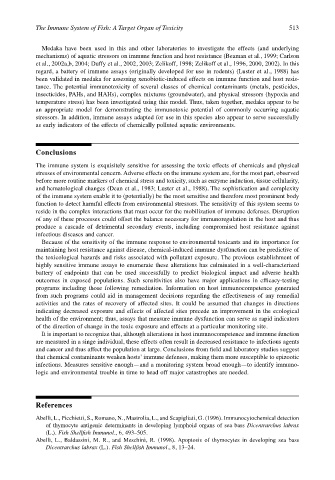Page 533 - The Toxicology of Fishes
P. 533
The Immune System of Fish: A Target Organ of Toxicity 513
Medaka have been used in this and other laboratories to investigate the effects (and underlying
mechanisms) of aquatic stressors on immune function and host resistance (Beaman et al., 1999; Carlson
et al., 2002a,b, 2004; Duffy et al., 2002, 2003; Zelikoff, 1998; Zelikoff et al., 1996, 2000, 2002). In this
regard, a battery of immune assays (originally developed for use in rodents) (Luster et al., 1988) has
been validated in medaka for assessing xenobiotic-induced effects on immune function and host resis-
tance. The potential immunotoxicity of several classes of chemical contaminants (metals, pesticides,
insecticides, PAHs, and HAHs), complex mixtures (groundwater), and physical stressors (hypoxia and
temperature stress) has been investigated using this model. Thus, taken together, medaka appear to be
an appropriate model for demonstrating the immunotoxic potential of commonly occurring aquatic
stressors. In addition, immune assays adapted for use in this species also appear to serve successfully
as early indicators of the effects of chemically polluted aquatic environments.
Conclusions
The immune system is exquisitely sensitive for assessing the toxic effects of chemicals and physical
stresses of environmental concern. Adverse effects on the immune system are, for the most part, observed
before more routine markers of chemical stress and toxicity, such as enzyme induction, tissue cellularity,
and hematological changes (Dean et al., 1983; Luster et al., 1988). The sophistication and complexity
of the immune system enable it to (potentially) be the most sensitive and therefore most prominent body
function to detect harmful effects from environmental stressors. The sensitivity of this system seems to
reside in the complex interactions that must occur for the mobilization of immune defenses. Disruption
of any of these processes could offset the balance necessary for immunoregulation in the host and thus
produce a cascade of detrimental secondary events, including compromised host resistance against
infectious diseases and cancer.
Because of the sensitivity of the immune response to environmental toxicants and its importance for
maintaining host resistance against disease, chemical-induced immune dysfunction can be predictive of
the toxicological hazards and risks associated with pollutant exposure. The previous establishment of
highly sensitive immune assays to enumerate these alterations has culminated in a well-characterized
battery of endpoints that can be used successfully to predict biological impact and adverse health
outcomes in exposed populations. Such sensitivities also have major applications in efficacy-testing
programs including those following remediation. Information on host immunocompetence generated
from such programs could aid in management decisions regarding the effectiveness of any remedial
activities and the rates of recovery of affected sites. It could be assumed that changes in directions
indicating decreased exposure and effects of affected sites precede an improvement in the ecological
health of the environment; thus, assays that measure immune dysfunction can serve as rapid indicators
of the direction of change in the toxic exposure and effects at a particular monitoring site.
It is important to recognize that, although alterations in host immunocompetence and immune function
are measured in a singe individual, these effects often result in decreased resistance to infectious agents
and cancer and thus affect the population at large. Conclusions from field and laboratory studies suggest
that chemical contaminants weaken hosts’ immune defenses, making them more susceptible to epizootic
infections. Measures sensitive enough—and a monitoring system broad enough—to identify immuno-
logic and environmental trouble in time to head off major catastrophes are needed.
References
Abelli, L., Picchietti, S., Romano, N., Mastrolia, L., and Scapigliati, G. (1996). Immunocytochemical detection
of thymocyte antigenic determinants in developing lymphoid organs of sea bass Dicentrarchus labrax
(L.). Fish Shellfish Immunol., 6, 493–505.
Abelli, L., Baldassini, M. R., and Meschini, R. (1998). Apoptosis of thymocytes in developing sea bass
Dicentrarchus labrax (L.). Fish Shellfish Immunol., 8, 13–24.

